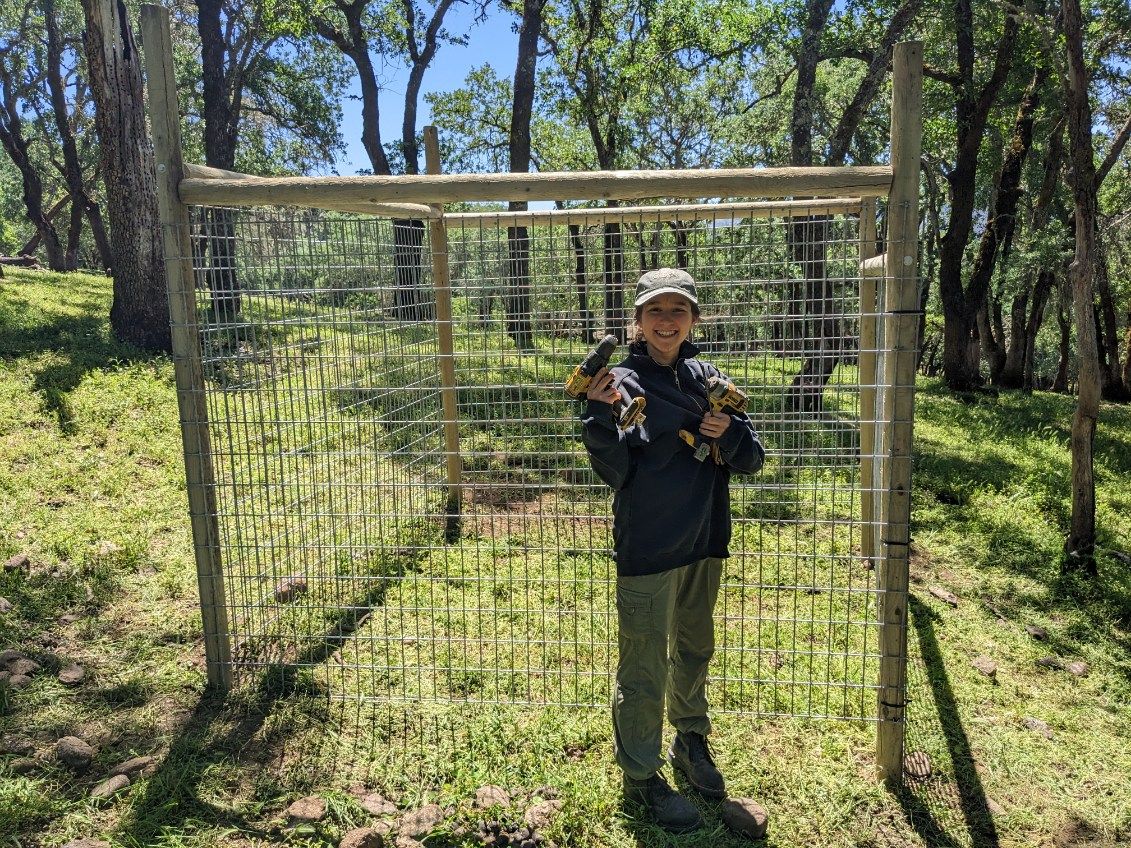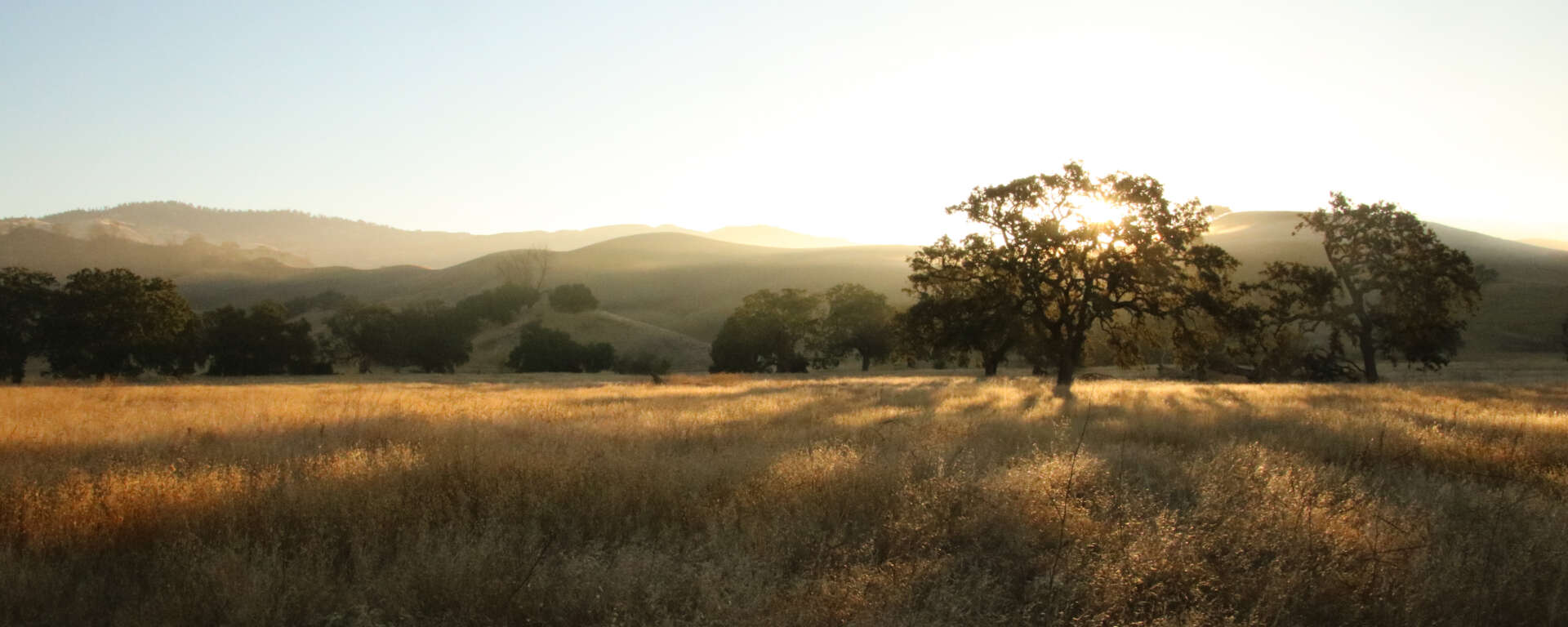Creating a Research Project: Oak Regeneration!
Posted in: Conservation, Goings on
At the beginning of 2022, I was asked to join a fledgling committee at Safari West. This new committee was dedicated to starting and maintaining research projects that would advance scientific knowledge in zoological facilities, improve the wellbeing of the animals in our collection, and provide a better understanding of native wildlife that lives on Safari West property. I was asked to join to help with the last of those three goals—I had previously worked as a research technician on a few projects studying the population dynamics of endangered birds in the Western US, and our research director Erika Defer hoped I could use some of the knowledge gained on those projects to start research at Safari West that looked at the interaction between our collection animals and the native landscape.

Osprey napping in an oak tree at Safari West
Safari West sits on 400 acres of rolling oak woodlands in the foothills of the Mayacamas mountain range. Many of the exotic animals here live in vast, sprawling areas that are close to 100 acres in size. As such, there are lots of interactions between the exotic animals that call Safari West home and the native wildlife surrounding them. Are these exotic animals having an impact on our native ecosystems? If so, what kind of impact? These are the questions we hoped to shed some light on.
With so many potential native species to study, it was hard to know where to start! A newly trained tour guide, Lizy Bean, finally helped me narrow things down during a brainstorming session by asking, “what could you research that would have the biggest long-term impact on the native ecosystems of Safari West?” My mind immediately jumped away from my comfort zone of birds, and towards the keystone species that those birds rely on every day—oak trees.

An adult male eland antelope reaching for oak leaves at Safari West
I started reading research papers about oak trees and reaching out to people with much more knowledge than me. Both Denise Cadman, a Safari West guide with decades of experience planting and protecting young oak trees in her previous career as an Environmental Specialist for the City of Santa Rosa and Hall Kushman, a professor at the University of Nevada, Reno who specializes in the influence of native and domestic herbivores on plant and animal communities were instrumental in shaping my understanding of research into oak recruitment. “Recruitment” simply means the addition of new, young individuals into a population, ensuring that population sticks around when older individuals die.

In a stable population, new seedlings are needed to replace old trees
I learned that a few species of oaks in California, notably blue oaks (Quercus douglasii), have been struggling with recruitment across the state. New oak trees are not growing as fast as old oak trees are being lost, resulting in shrinking blue oak populations. Scientists are not sure exactly why this is, but one potential culprit is livestock munching on too many young oaks before they are old enough to withstand heavy herbivory. Anecdotally I saw this happening in a few of our habitats at Safari West—exotic grazers and browsers were eating most, if not all of the young oak seedlings and saplings. Oaks have a long lifespan, with blue oaks living to anywhere between 150 and 400 years of age. This recruitment issue isn’t a short term problem, but if there are no young oaks to replace the old trees as they grow old and die in the coming decades, these habitats will slowly transform from beautiful oak woodlands to barren landscapes. I had found a project!

Sunrise over an oak savanna in Sedgewick Reserve, California
Denise and I started tagging new oak seedlings in a section of one of our back habitats that had been fenced off from our animals due to erosion concerns. I learned that this type of area is called an “exclosure”. While enclosures are designed to keep things in, exclosures are designed to keep things out. We learned what we would need to measure to keep track of a young oak’s growth and survival: how tall is it? How many leaves does it have? How many of those leaves have been damaged by herbivory? Roughly how many seedlings are under a tree? How much canopy cover (shade vs. sun) is above the seedling? How compact is the soil that the seedling is growing in? All of these factors and more could affect the success or failure of a young oak.

Early oak data collection sheets
As Denise and I were figuring out basic research methods, the research committee was helping me find long-term help for the project. We were unbelievably lucky to have Derek Girman and Victoria Brunal join our research committee—Dr. Girman is a Biology professor at Sonoma State University, and Victoria is a recent graduate student of his that became our research coordinator. While I had been involved with research projects and had a basic understanding of data collection and analysis, Derek and Victoria quickly moved this project from me fumbling in the dark with a decent idea to the creation of a legitimate, achievable plan. Derek thought that this would be a great Master’s project, and recruited Bella Boggio to take on this research. Our core oak team became me (Mark), Bella, and Victoria, with Derek as our advisor.

Victoria, Mark, and Bella: Team Oak!
The basic premise of our project was simple—we wanted to determine who or what was responsible for the low oak recruitment in our habitats, and figure out how much protection a young oak would need to survive. The most likely culprits are either our exotic grazers and browsers (zebra, buffalo, ostrich, and a variety of antelope), or native small mammals, like ground squirrels.

Planting layout for our oak exclosures
To accomplish this, we needed a way to keep young oak seedlings safe from herbivory. After lots of literature review and brainstorming conversations, and tons of help from the Safari West maintenance and landscaping departments, we settled on a smaller exclosure design of 7.5 square feet, with 5 foot tall fences to keep our animals out. Through lots of hard manual labor (I now have a lifelong respect for those who dig holes for fencing in rocky dirt), we were able to build 20 of these exclosures during the spring and summer of 2023!

Overcoming challenges—like this rock we needed to dig up to place our final exclosure!
At the end of 2023, it was time to collect acorns to plant! We collected hundreds of acorns from 8 different parent trees, and pre-germinated them in vermiculite. Half of the acorns were planted just after germination, while the other half were jump-started in a greenhouse at Sonoma State University for a few months. There is some data saying that the more you “coddle” a young oak by starting its life in a greenhouse, the more it will struggle when it enters the “real world”, but we wanted to test that hypothesis as part of our research.

Seedlings being jump-started in a greenhouse
We planted a total of 24 germinated acorns and 12 jump-started seedlings in and around each exclosure, for an overall total of more than 700 oaks planted! Once we had planted, we wanted to provide some additional protection against small mammals for some of the young oaks, so we built and installed 160 wire mesh cylinders around half of the planting sites inside of the exclosures. We also tagged about 50 naturally germinated seedlings in an area of our property far away from strong grazing pressures, as a control to compare with our experimental trees. After lots of hard work planting and protecting, it was time to wait. Research shows that it is important for young oaks to acclimate to the climate they are in, so once we planted we didn’t provide any additional aid in the form of water or nutrients.

One of our exclosures surrounded by zebra and eland
At the time of this blog post, the wait is almost over! During the winter it can be very difficult to find baby blue oaks, as they lose their leaves just like their parents, leaving only a tiny twig sticking out of the ground. But spring is here, the parent oaks are starting to leaf out, and hopefully so are some of our seedlings. Next week, we will be going out to all of our exclosures to see how everyone is doing. Oaks use the reproductive strategy of throwing out thousands of babies and hoping for the best, but it only takes one of those babies making it to adulthood to replace the parent tree once it dies. So, we’re expecting that most of our seedlings will not have made it through the winter, but if even just one young oak per exclosure makes it to adulthood, we will have been successful in helping our oak forest regenerate. Our hope is that the results of our study will assist Safari West in developing long term management plans for our oak woodlands, as well as help other zoological facilities and land owners with grazing livestock make sure the blue oak woodlands of California stick around for generations to come.

Thanks for reading along! For more information on this project and other Safari West research initiatives, check out the [Research] page on our website.


